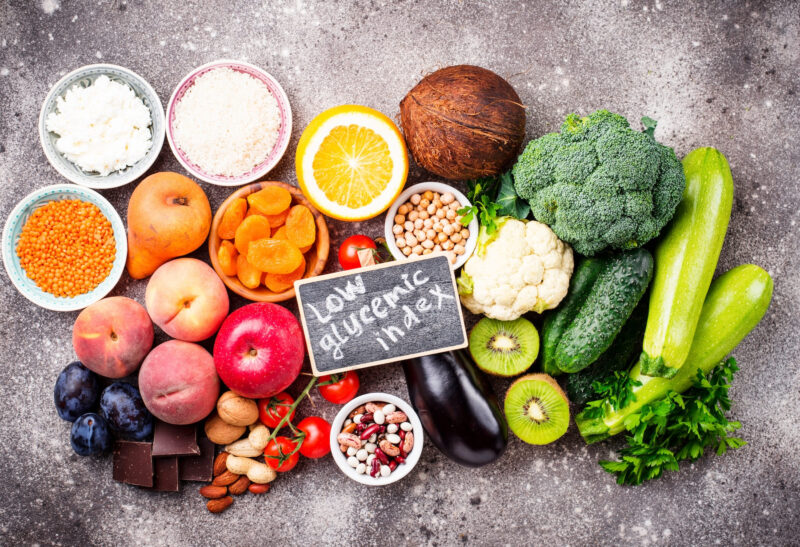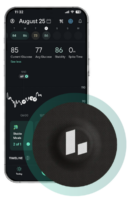Different foods have different impacts on blood sugar (glucose) levels. Case in point: A bowl of fiber-rich raspberries triggers a more subtle rise and fall in blood sugar than a handful of pretzels, as pretzels contain refined carbohydrates and hardly any fiber, protein, or fats to slow their digestion into glucose and subsequent absorption into the bloodstream. Why does this matter? Over time, blood sugar spikes contribute to insulin resistance, which contributes to chronically elevated blood sugar and conditions like diabetes, heart disease, and dementia.
Fortunately, there are dietary and lifestyle strategies and tools to help minimize fluctuations in blood sugar and counter these metabolic consequences. One such tool is the glycemic index (GI)—a system that ranks carb-containing foods by how quickly they cause blood sugar to rise. The idea: By prioritizing low-GI foods, you’ll have fewer spikes and dips and better metabolic health.
But while GI is a helpful reference, it’s not a perfect tool—its methodologies are narrow, and it ignores individuality. So, it shouldn’t be the only way you assess carb quality or your only strategy for supporting blood sugar balance. Below, learn how it works, when it’s useful, and what else to consider.
What is the glycemic index, and what can it tell you?
GI is a ranking system that classifies carb-containing foods on a scale from 0 to 100 based on how quickly they raise blood sugar compared to an equal amount of pure glucose (which has a GI of 100). A food’s GI is calculated by comparing the extent to which 50 g of available carbs (i.e., total carbs minus fiber) from a given food raises blood glucose compared to 50 g of glucose or white bread.
The rise is calculated from what’s called the Incremental Area Under the Curve (iAUC), or the total rise in glucose over time after eating the food. It’s compared to iAUC of the reference food to determine the score using this equation: GI = (iAUCtest food/iAUCglucose) x 100.
GI is not calculated for carb-free foods like meats.
Here’s the idea: The lower a food’s GI, the slower blood sugar rises after eating it, and the lower the body’s insulin response. While minor fluctuations in blood sugar levels after eating are entirely normal (ideally rising no more than 30 mg/dL, per Levels experts), repeated spikes can damage your health. The goal of categorizing foods based on GI is to help people understand which carb-containing foods are most and least likely to cause these spikes.
Carb-containing foods may be classified as follows using the GI:
- Low glycemic index: 55 or lower
- Moderate glycemic index: 56-69
- High glycemic index: 70 or higher
Some things that influence glycemic index: The presence of fiber, protein, or fat within a carb-containing food results in a lower GI. So foods that lack these nutritional components and are higher in sugars, starches, and refined carbs (e.g., sodas, candy, potatoes, refined grain products like white rice and pasta) have a higher GI compared to whole foods like non-starchy vegetables, berries, unrefined grains, nuts, and seeds. For example, peanuts have a GI of 18, while cornflakes have a GI of 79. Riper fruits (think: a freckled banana) will also have a higher GI than unripe fruits (a green-tipped banana).
But GI isn’t always a practical tool. Case in point: It doesn’t consider how much food you eat, so it can’t always accurately predict how much blood sugar will rise after eating a typical serving size. Consider watermelon: It has a high GI of 76 (the same as a donut), but a serving contains just 11 g of carbs, so you’d need to eat closer to 4-5 servings to reach the 50 g of carbs necessary to trigger this “high” degree of blood glucose response.
To better understand a food’s impact on blood sugar, you need to look at not just how much glucose it contains but also how quickly the body absorbs that glucose into your bloodstream. This need led to a new measurement: glycemic load (GL). GL adjusts GI to a food’s typical serving size. It’s calculated by multiplying the available carbs in a serving of a food by the GI, then dividing by 100. When you do this, watermelon has a low GL of 8, while a donut has a high GL of 17.
Carb-containing foods may be classified as follows using GL:
- Low glycemic load: 1-10
- Moderate glycemic load: 11-19
- High glycemic load: 20 or higher
Keep in mind: While GL may be more practical than GI for predicting postprandial blood sugar response (i.e., blood sugar after eating), neither accounts for the fact that people typically eat foods in the context of mixed meals and snacks. Adding foods containing protein, fiber, and fat can help slow the absorption of glucose into the bloodstream and lower the overall glycemic impact of a meal, even if it contains a higher glycemic ingredient. This is why it’s a good idea to pair fruit with nut butter, add nuts and seeds to oatmeal, or add protein powder to smoothies. So, you can use a food’s GI or GL as a guide while understanding that food combinations will have a different glycemic impact than their components.
What are the limitations of the glycemic index? Imperfect methodologies and more
GI and GL appear to be somewhat helpful in getting a general idea of which carb-containing foods most significantly impact blood glucose, but there are significant limitations to using these in isolation—particularly if you want to optimize metabolic health.
First, consider the somewhat inconsistent testing methodology used to determine GI values. While a set of international standards was developed for this in 2010 (ISO 2010), the standards still give researchers a choice in how to carry out tests in several key areas—leaving room for variability in results. For example, the source and form of glucose used, where blood is collected (capillary vs venous collection), what (if any) drink is provided during testing (water, tea, coffee, etc), and the device used to analyze blood glucose (glucometer or other clinical glucose analyzers) may all differ. Additionally, GI is typically calculated using only a tiny pool of subjects, often as few as 10 people. Given the individual variability in glucose response, these small sample sizes make GI (and GL) challenging to generalize.
Beyond these imperfections in determining a food’s GI, here are several more reasons GI and GL shouldn’t be the only tool used to plan healthy, blood sugar-friendly meals:
- GI doesn’t account for how much you eat, as mentioned above. To a point, this can be addressed by focusing on GL, which predicts blood sugar response after eating a typical portion size of a carb-containing food. But remember that larger portions will increase GL, and your typical serving may not be reflected on GL food lists.
- A food’s GI and GL ranking only applies when the food is eaten on an empty stomach and not consumed with other foods. GI and GL change once you combine foods in typical meals and snacks—so these tools aren’t nearly as straightforward as they seem.
- GI ignores fructose, another type of sugar commonly found in fruit, as well as in high-fructose corn syrup and table sugar (which is half sucrose, half fructose). Fructose has a low GI as the body processes it differently than glucose, but in excess, it can drive fatty liver, insulin resistance, and other cellular damage. See Levels advisor Dr. Robert Lustig’s take on GI and fructose here.
- GI and GL don’t account for a person’s individual blood sugar response to foods, which can be highly variable and influenced by more than macronutrient composition. Glycemic response is influenced by genetics, the gut microbiome, sleep status, physical activity, stress levels, what you’ve eaten recently, and more. So, for example, you might respond well to rice but poorly to bananas, while your friend has the opposite response. The study also notes that there can be high variability within a single individual’s response.
- Neither GI nor GL consider a given food’s overall quality or nutrient density. For example, potato chips (as low as 48) have a lower GI than a baked sweet potato (83)—but no one would argue that chips are “healthier.” For this reason, GI and GL should always be considered along with other factors such as the level of processing and presence of other nutrients (e.g., fiber, protein, fats, vitamins, minerals, antioxidant compounds, etc).
When is it useful to consider glycemic index?
The concepts of glycemic index and glycemic load were initially developed in the 1980s and 90s to help people with diabetes choose foods that keep blood sugar in a healthy range. And today, European organizations like Diabetes UK specifically include high-fiber, low-GI/GL diets in their diabetes-prevention recommendations. While it’s important to understand the genuine limitations of GI and GL (outlined above), referencing GI and GL food lists may still be one valuable tool for meal planning. Case in point: Several studies suggest that low-glycemic diets (particularly ones high in fiber) curb the risk of Type 2 diabetes, cardiovascular disease (CVD), and other metabolic risk factors. Here are a few potential perks:
- Diabetes: People in the lowest quintile (or bottom 20%) of dietary GI had a 33% reduced risk of Type 2 diabetes compared to those in the highest quintile, according to a large meta-analysis. Fiber, which slows the absorption of glucose into the bloodstream, appears to be a key factor in curbing risk—the same meta-analysis found that low-GL, high-fiber diets were associated with a 47% reduced risk of Type 2 diabetes compared to high-GL, low-fiber diets. In another small study, a low GI diet reduced the number of women with gestational diabetes mellitus (GDM) who needed to use insulin by about half.
- Metabolic syndrome: A meta-analysis found that low-GI diets helped lower fasting blood glucose, HbA1c, total cholesterol, and LDL cholesterol. In another small study, eating a low-GL, Mediterranean-style diet for three months was associated with reductions in waist circumference, insulin resistance, blood pressure, triglycerides, LDL, and TNF-α (a marker of inflammation) in 25 women with metabolic syndrome.
- Cardiovascular disease: High dietary GI was associated with a 13% increased risk of CVD and high dietary GL was associated with a 23% increased risk of CVD compared to a low dietary GI and GL in a meta-analysis of 14 studies. (Chronically high blood sugar promotes blood vessel damage and plaque buildup.) Interestingly, women and people on the high end of overweight appear to be at increased risk for cardiovascular complications (e.g., coronary heart disease and stroke) related to high-glycemic eating patterns. Other research suggests that low-glycemic diets lower total and LDL cholesterol, but only when they’re high in fiber.
In daily life, you can use The University of Sydney’s searchable GI/GL databases or reference any number of GI/GL food lists online to create low-glycemic meals that may be less likely to spike blood glucose levels (think: a stir-fry with quinoa, broccoli, and chicken)—but these aren’t perfect metrics.
The most effective ways to manage blood sugar response
Scanning food lists and plugging every food you consume into GI/GL databases isn’t always realistic—and given the potential drawbacks outlined above, it may not be worth the effort. A more sustainable strategy to create low-glycemic meals and snacks is to understand the categories of foods and types of food pairings that tend to minimize the body’s glycemic response and to use this as a general framework for planning your food intake. Here’s how, along with some other strategic ways to optimize your body’s blood sugar response after eating:
- Focus on diet quality: Aim for your diet to be composed primarily of whole and minimally processed foods. Think: Vegetables (especially non-starchy veggies), fiber-rich fruits, quality meats and fish, legumes, nuts and seeds, whole grains, and healthy fats such as olive and avocado oil. Not only have minimally processed foods been associated with improved glycemic response and greater satiety compared to highly processed foods, they’re also a much richer source of vitamins, minerals, and antioxidants that support metabolic health.
- Dress up your carbs with fiber, protein, and fat: You don’t have to drastically cut carbs to curb the rise in blood glucose after a meal. Another strategy: Focus on fiber-rich carbs (think: vegetables, fruits, legumes) and pair them with a source of protein and fat. These nutrients are your “blood sugar buffers.” Fiber is indigestible, so it slows the breakdown of carbs into glucose and the subsequent absorption of that glucose into the bloodstream; and protein and fat signal the release of gut hormones that slow gastric emptying, which also slows glucose absorption. Try this: Pair fruit with nut butter or cheese, dip carrots in hummus, add nuts and seeds to oatmeal, add protein powder to smoothies, add collagen to baked goods recipes, pair a square of dark chocolate with a handful of almonds, pair whole grains with a protein (salmon, chicken, tofu) and non-starchy veggie (broccoli, asparagus, spinach) cooked in a healthy fat (olive oil).
- Move your body after meals: Consider taking a lap or two around the block, your apartment, or the office after your meals. When your muscles are actively working during cardio, they essentially suck up glucose from the bloodstream to burn for fuel, which in turn helps lower blood glucose levels. Even 2-5 minute bouts of activity throughout the day can significantly lower post-meal blood sugar levels compared to remaining sedentary, per one study.
- Learn your personal glycemic response: As mentioned above, everyone has a unique response to carbohydrate-containing foods. The easiest way to evaluate your response to specific foods and modify intake accordingly is by using a continuous glucose monitor (CGM), which shows you your blood sugar in near real-time. This lets you test foods and see your specific response. Remember, you don’t want your blood sugar to rise more than 30 mg/dL after a meal—if it does, that may be an indicator that you need to opt for a smaller serving size of a particular food or be particularly mindful about the way you pair it with other foods to help minimize its impact on blood sugar levels.
 Ready to try a CGM yourself?
Ready to try a CGM yourself?
The best way to understand how well your body processes your diet is with a continuous glucose monitor and an app like Levels to help you interpret the data. Levels members get access to the most advanced CGMs and personalized guidance to build healthy, sustainable habits. Click here to learn more about Levels.

 Ready to try a CGM yourself?
Ready to try a CGM yourself?






